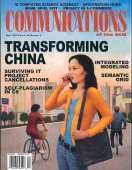April 2005 - Vol. 48 No. 4

Features
The Two Sides of Roi: Return on Investment vs. Risk of Incarceration
The State of Funding For New Initiatives in Computer Science and Engineering
Top 10 Downloads from Acm’s Digital Library
A New Technonationalism?: China and the Development of Technical Standards
Diffusion, Use, and Effect of the Internet in China
Internet Diffusion in Chinese Companies
The Internet Enlightens and Empowers Chinese Society
The E-Transformation of Western China
It Is Not For Everyone in China
Computer-Related Technostress in China
Surviving It Project Cancellations
Self-Plagiarism in Computer Science
Performance Benefits Through Integration Hubs
Privacy in E-Commerce: Stated Preferences vs. Actual Behavior
Integrated Modeling: the Key to Holistic Understanding of the Enterprise
A P2p Genetic Algorithm Environment For the Internet
Semantic Grid: Scientific Issues, Infrastructure, and Methodology
Two-Factor Authentication: Too Little, Too Late



